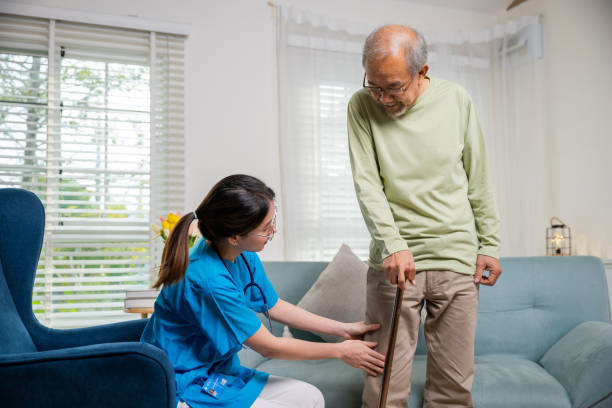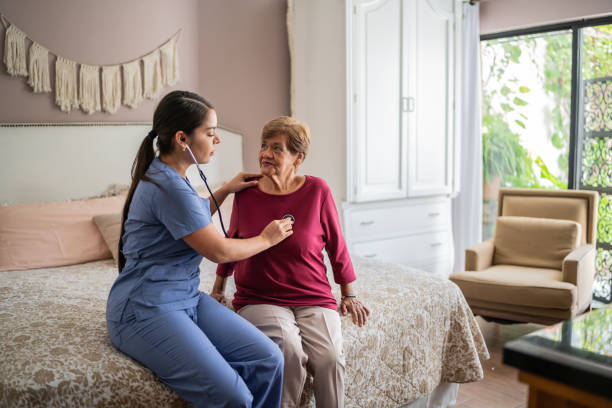The Challenges of Parkinson’s Disease: Symptoms, Causes, and Coping Strategies
Parkinson’s disease is a progressive neurological disorder that affects millions of people worldwide. While it is most commonly associated with the motor symptoms of tremors, rigidity, and slowed movements, Parkinson’s is a complex condition that can impact many aspects of an individual’s physical, cognitive, and emotional well-being. As the disease progresses and symptoms worsen over time, those affected and their loved ones face immense challenges in managing this chronic illness.

In this comprehensive blog post, we’ll explore the nature of Parkinson’s disease, its causes, symptoms, treatment options, and strategies for coping with the far-reaching effects it can have on daily life.
What is Parkinson’s Disease?
Parkinson’s disease is a neurodegenerative disorder that occurs when brain cells (neurons) responsible for producing the neurotransmitter dopamine become impaired and die. Dopamine plays a vital role in regulating movement and coordination within the body. As dopamine levels progressively drop due to this neuronal damage and death, it causes abnormalities in brain activity, resulting in the motor symptoms and other complications associated with Parkinson’s.
The exact causes of Parkinson’s disease are not fully understood, but researchers believe it likely results from a complex combination of genetic and environmental factors that trigger the disease process. While Parkinson’s primarily affects older adults, with most cases occurring after age 60, it can also develop in younger individuals in more rare circumstances.
The Progression of Motor Symptoms
The hallmark motor symptoms of Parkinson’s disease include:
•Tremors: Involuntary shaking or trembling, often starting in one hand, arm or leg
•Bradykinesia: Slowed movements, difficulty initiating movement, shorter stride length
•Rigidity: Stiffness of the trunk, arms, or legs due to increased muscle tone
•Postural Instability: Poor posture, balance problems, increased risk of falls
These movement-related symptoms typically start gradually and progress slowly over time, though the rate of progression varies from person to person. The longer an individual has Parkinson’s, the more pronounced the physical impairments become, significantly impacting mobility, daily functioning, and independence.
Non-Motor Symptoms
While the movement-related symptoms are most visible, Parkinson’s disease can also cause a wide range of non-motor symptoms that are just as challenging:
•Cognitive Impairments: As the disease progresses into later stages, some people may experience memory problems, slowed thinking, confusion, and even dementia.
•Sleep Disorders: Disrupted sleep patterns are common, including insomnia, excessive daytime sleepiness, restless leg syndrome, and rapid eye movement (REM) sleep behavior disorder.
•Emotional Changes: Depression, anxiety, apathy, and other mood or personality changes can occur due to chemical disruptions in the brain.
•Speech/Swallowing Issues: Parkinson’s can affect the muscles used in speaking and swallowing, resulting in quieter voices, slurred speech, drooling, and difficulty swallowing.
•Gastrointestinal Problems: Constipation is very common, as the disease can slow digestive tract contractions. Some experience nausea or vomiting.
•Bladder Problems: The ability to control bladder function is often impaired, causing urgency and frequency issues.
As non-motor symptoms like these become increasingly prevalent in later stages, they can profoundly impact an individual’s daily functioning and quality of life.
Causes and Risk Factors
While there is still much to be learned about what exactly causes Parkinson’s disease, researchers have identified several key risk factors associated with its development, including:
•Age: The largest risk factor is simply getting older, as most cases occur after age 60.
•Genetics: Certain genetic mutations and variations appear to increase Parkinson’s risk, especially for younger onset cases. Having a close relative with Parkinson’s also elevates one’s risk.
•Gender: Men have a slightly higher risk of developing Parkinson’s compared to women.
•Environmental Exposure: Research indicates potential links to certain toxins or environmental factors that may trigger Parkinson’s in genetically predisposed individuals.
•Head Injuries: Traumatic brain injuries, especially repeated concussions, may increase risk in some people.
Treatment Options
While there is no cure for Parkinson’s disease yet, a variety of medications and therapies can help manage symptoms and improve quality of life:
•Dopamine Replacement Therapy: Medications like levodopa help replenish dopamine levels to reduce motor symptoms like tremors and rigidity.
•Other Medications: MAO-B inhibitors, dopamine agonists, COMT inhibitors, and anticholinergics can further improve motor function by impacting brain chemicals.
•Deep Brain Stimulation: An advanced surgical treatment involving implanted electrodes that precisely stimulate areas of the brain to block symptoms.
•Physical/Occupational Therapy: Working with therapists to maintain motor skills, strength, flexibility, balance, and independence with daily activities.
•Speech Therapy: Techniques and exercises aimed at improving speech volume, clarity and swallowing.
•Exercise: Regular exercise routines tailored to improving mobility and preventing muscle stiffness.
•Support Groups: Interacting with others impacted by Parkinson’s in a supportive group environment.
As Parkinson’s progresses, treatment plans often require a combination of different medication, therapy, and surgical approaches to effectively manage the increasingly complex array of motor and non-motor symptoms.
Emotional and Lifestyle Impact
Being diagnosed with Parkinson’s disease can trigger intense emotional upheaval and lifestyle adjustments for both the individual and their loved ones. Common challenges include:
•Fear and Anxiety: There is often immense anxiety over how rapidly the disease may progress and inability to perform routine daily tasks.
•Depression: The neurological changes of Parkinson’s, combined with lifestyle impacts, increase depression risk substantially.
•Social Issues: Difficulties with mobility, speaking, and social situations can lead some to avoid interactions and isolate themselves.
•Caregiver Strain: As the person’s needs increase over time, extreme physical and emotional demands are placed on caregivers like spouses and family members.
•Job/Financial Impacts: Depending on the individual’s age and disease progression, there may be job changes, disability leave, or retirement needed due to impaired function.
•Self-Care Issues: Simple self-care activities like bathing, getting dressed, and toileting can become extremely challenging without assistance.
This highlights how Parkinson’s extends far beyond just physical impairments. Proactively utilizing counseling, support groups, respite care, and other emotional/mental health resources is crucial.
Coping Strategies and Self-Care
Although undeniably life-changing, Parkinson’s disease doesn’t have to define an individual’s identity or prevent them from living a meaningful, purpose-driven life. With the right therapies, accommodations, and mindset, it’s very possible to thrive despite this chronic condition. Consider these key coping strategies:
•Keep Physically Active: Sticking to an exercise regimen tailored for Parkinson’s can help slow symptom progression, improve mobility, build strength and balance, and provide an overall mood boost.
•Prioritize Mental Health: Don’t neglect emotional and psychological needs. Support groups, counseling, meditation, yoga, and mindfulness practices can help manage Parkinson’s effects.
•Adapt the Environment: Assess the individual’s environment (home, car, workplace) and make modifications to increase accessibility, safety, and independence as needed.
•Stay Socially Connected: While it requires effort, purposefully maintaining an active social network can prevent isolating tendencies and provide an invaluable support system.
•Follow Medication Regimen: Adhering to the prescribed medication schedule is imperative for keeping dopamine levels steady and reliably controlling motor symptoms.
•Voice Exercises: Practicing vocal warmups, projection drills, and swallowing exercises regularly can prevent speech and swallowing issues from worsening.

•Diet and Nutrition: Eating a nutritious, balanced diet provides energy, boosts immunity, and may even help relieve some non-motor symptoms like constipation.
With a proactive, multidisciplinary approach aimed at managing both motor and non-motor symptoms, most individuals with Parkinson’s disease can maintain independence and an enriched quality of life for many years after diagnosis.
The Search for a Cure
While there is still no cure for Parkinson’s disease as of now, a tremendous amount of research is underway to better understand its causes and pathology in hopes of ultimately finding more effective treatments and preventive strategies. Several promising areas of scientific discovery include:
- Genetic Research: Identifying the specific gene mutations and markers that contribute to Parkinson’s risk can unlock more targeted treatment approaches.
- Alpha-Synuclein Studies: This protein appears to be a key factor in brain cell death and Lewy body formation. Finding ways to reduce alpha-synuclein clumping and clear it from neurons could potentially slow or stop Parkinson’s progression.
- Stem Cell Therapies: Replacing damaged dopamine-producing neurons with new cells derived from stem cells is an active area of study that could restore normal brain function.
- Drug Development: Researchers are working to develop new medications that can better protect dopamine neurons, reduce inflammation, remove toxins, and block abnormal protein formations.
- Early Detection: Improving methods for detecting Parkinson’s earlier, before significant brain damage occurs, would allow interventions at a point when protecting neurons is still possible.
- Disease Modeling: Advanced models that mimic Parkinson’s disease progression, such as those using induced pluripotent stem cells, provide vital platforms for testing new therapies.
With worldwide collaboration and funding for Parkinson’s research increasing every year, there is hope on the horizon. Incremental advances in our understanding of Parkinson’s pathology and onset mechanisms will continue paving the way toward better symptom management now and perhaps even neuroprotective or disease-modifying treatments in the future.
No one should have to suffer the debilitating effects of Parkinson’s disease without resources, support, and the professional care needed to preserve quality of life for as long as possible. By raising awareness, providing education, accelerating research efforts, and prioritizing compassionate, patient-centered care, we can make a powerful difference for the millions affected worldwide as we strive for a world free from Parkinson’s.
Conclusion
Parkinson’s disease is a formidable neurological condition that profoundly impacts the lives of millions worldwide. Its motor symptoms of tremors, rigidity, and bradykinesia gradually strip away an individual’s independence and mobility. But it extends far beyond just physical impairments – Parkinson’s can devastate cognition, sleep, mood, speech, and nearly every aspect of daily functioning as it insidiously progresses over time.
The challenges posed by this complex disease are immense, both for those diagnosed and their caregivers and loved ones. Living with Parkinson’s requires tremendous courage, determination, and resilience in the face of such difficulty. It demands making constant adjustments and lifestyle accommodations as symptoms escalate. Most of all, it necessitates a proactive, multidisciplinary treatment approach that combines available medications, therapies, mental health support, and informed self-care strategies.
While there is still no cure, and the future can feel frightening and uncertain at times, the Parkinson’s community is motivated, dedicated, and unified in advocating for more research toward better disease management, earlier diagnosis, neuroprotective treatments, and one day, an ultimate cure. Substantial investments and collaborative efforts across the scientific field have uncovered promising new insights into Parkinson’s pathology and opened the door for more targeted and effective therapies on the horizon.
In the meantime, open communication, awareness, education, and access to quality care remain paramount for improving quality of life for those touched by this devastating disease. By adopting a positive mindset, actively engaging in one’s treatment plan, and surrounding oneself with a strong care partner team and support network, it is very possible to live purposefully and joyfully despite Parkinson’s obstacles. With courage, compassion, and an unwavering perseverance to keep moving forward, the Parkinson’s community will continue making inspiring strides.